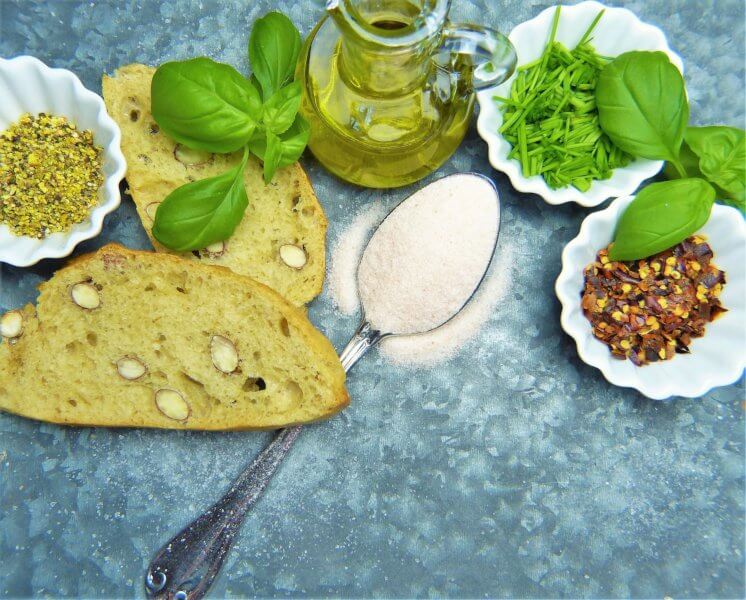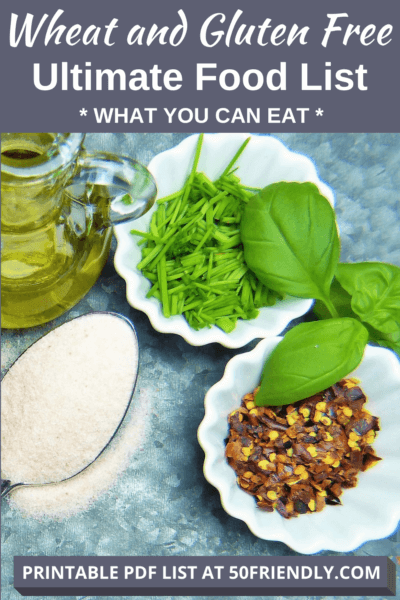So now I bet you’re wondering, “what can I eat?” We’ll here’s a starting list of foods that won’t expose you to the bad grain or make you fat and diabetic, but good foods that will fit into your healthy lifestyle.
NOTE: there are no fruits or vegetables listed here because they are naturally free of wheat and gluten and you can eat fruit and vegetables to infinity and beyond. Just use your good judgement when it comes to eating large amounts of fruits that contain high levels of sugar.
Click here for the Wheat and Gluten Free Printable Food List
SHIRATAKI NOODLES
DAIRY PRODUCTS
Buttermilk
Cream
Cream cheese
Greek yogurt, unsweetened and unflavored
Kefir, unsweetened and unflavored
Milk
Yogurt, unsweetened and unflavored
Cheese (except Gorgonzola and blue cheese)
FISH AND SHELLFISH
Catfish
Clams
Cod
Crab
Halibut
Lobster
Mahi Mahi
Mussels
Octopus
Oysters
Perch
Red Snapper
Salmon
Shrimp
Squid
Trout
Walleye
GRAINS – on occasion and consumed cautiously
Amaranth
Buckwheat
Corn
Millet
Quinoa
Rice, white and brown
Sorghum
Teff
Wild Rice
HERBS AND SPICES
Allspice
Anise
Basil
Bay Leaf
Caraway
Cardamom
Celery Seed
Cilantro
Cinnamon
Clove
Coriander
Dill
Fennel
Fenugreek
Garlic
Marjoram
Mint
Mustard
Oregano
Paprika
Parsley
Pepper
Rosemary
Saffron
Sage
Salt, sea salt
Star Anise
Tarragon
Thyme
Turmeric
Wasabi
LEGUMES
Black Beans
Black-eyed Peas
Carob
Chickpeas (garbanzo beans)
Kidney Beans
Lentils
Mesquite
Peanuts
Peas
Pinto Beans
Red Beans
Soybeans
Spanish Beans
Vanilla, vanilla beans
MEATS, POULTRY AND EGGS
Beef
Buffalo
Chicken
Duck
Eggs
Elk
Lamb
Ostrich
Pheasant
Pork
Quail
Turkey
NUTS AND SEEDS
Almonds
Brazil Nuts
Cashews
Chia Seeds
Filberts
Flaxseeds
Hazelnuts
Peanuts
Pecans
Pistachios
Pumpkin Seeds
Sesame Seeds
Sunflower Seeds
BAKING PRODUCTS
Almond Meal and Flour – for muffins, cookies, and cakes
Coconut Flour – use as an additive to breads and a thickener for gravies. Used to modify the texture and flavor of nut meals.
Garbanzo Bean (chickpea) Flour – used to lighten up nut flours
Ground Golden Flaxseed – used as an addition to nut meals and flours. If used alone it will yield a crumbly texture.
Hazelnut Meal – an alternative to almond meal and flour
Pecan Meal – used as a replacement for almond meal. Used for pie crusts to replace graham crackers, or for muffins and cookies
Pumpkins Seed Flour
Sesame Seed Meal – for dishes that have cheeses, peppers, onions,
Sunflower Seed Meal – Can be added to more expensive flowers to cut cost. Provides a heavier, chewier product like cookies. Not good for cakes.
Walnut Meal – good for pie and cheesecake crusts. Can be interchanged for almond meal or flour, but will have a heavy texture. Not good for cakes
OILS
Coconut Oil – most versatile, cooking-friendly, heat tolerant and most healthy oil
EVOO – extra virgin olive oil. Rich in antioxidants and mono-unsaturates, and very delicious.
Flaxseed Oil – has a strong nutty flavor and can be bitter. Use with dishes that have a vegetal taste.
ELOO – extra light olive oil. Very useful in brownie and cupcake recipes
Walnut Oil – very baking compatible
Avocado Oil – useful for recipes with vegetal tastes. Great for cooking
Butter – use sparingly unless its pure organic
SWEETENERS
Stevia – a versatile and safe sweetener, useful for nearly all recipes that sweetness is required without the calorie burden.
Erythritol – is a useful and safe sweetener for most of the wheat belly recipes
Xylitol – very baking friendly and add browning to the exterior or breads and muffins
Sucralose (Splenda) – has been proven to be safe in consumption, but have been reported to have potential adverse effects. Your choice whether to use or not.
Truvia (rebid a and erythritol) – provide a bit more rise to wheat free breads and muffins, more than stevia can do.
********************************************
So now that you have your starting list of foods that you can eat while removing wheat and gluten from your diet, stay tuned for the Wheat Belly Shopping List that will, as William Davis, MD says:
“include essentials that will help you navigate a wheat free diet easily and conveniently. These foods form the backbone of a healthy wheat free lifestyle and provide the basic ingredients necessary to create the unique recipes that fit this approach.”


